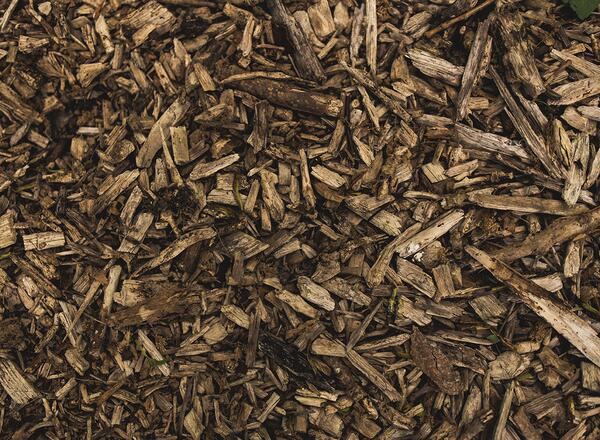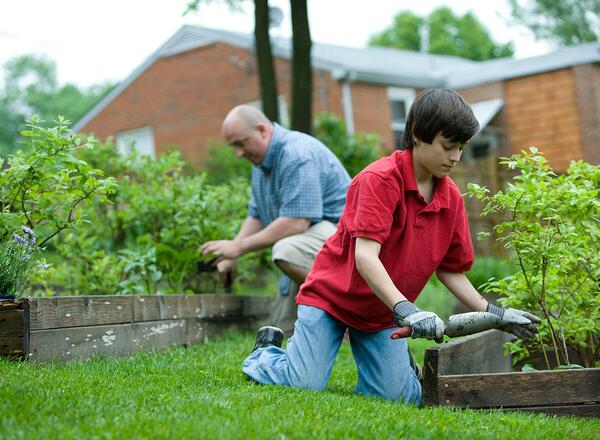
Roses do best with uniform soil moisture throughout the growing season. The general rule of thumb suggests that one inch of water be applied per week during the growing season. The amount and frequency of application will depend on soil type. Sandy soils will need more frequent irrigation than heavier clay soils. Hot temperatures would call for more frequent irrigation, also. The use of soaker hoses in rose beds is highly encouraged. Water can be delivered in adequate amounts while keeping the foliage dry, preventing disease.
The use of mulch around roses to help retain soil moisture is a practice that is highly encouraged. Mulch will also help keep soils cool and help retard weed growth. Materials such as wood chips, straw, or dry grass clippings make good mulches. More decorative materials such as shredded hardwood bark or cocoa bean hulls could also be used. Mulches should be applied about 2-3 inches deep and replaced as needed. Because organic mulches tend to bind up nitrogen as they decompose, additional fertilizer may be needed to prevent nutrient deficiencies. Leave an un-mulched area about 6" in radius around the plant.
In order to maintain strong, healthy roses, it is important to establish an annual fertility program. Fertilization schedules vary depending on the types of roses being grown. For species roses, a spring application of general-purpose fertilizer is usually adequate for the season. General-purpose fertilizers such as 10-10-10 or 12-12-12 are used at about one-half to one cup per plant. Spread the fertilizer in a band starting six inches from the crown of the plant, going out to about 18 inches. Work it in lightly and water.

All other roses benefit from a second application about June 15 or at the end of the spring bloom period. For continuous-flowering or repeat-blooming roses, a third application in mid-July is suggested. No fertilizer should be applied after August 15 so as not to encourage soft, succulent growth that could be easily winter-damaged. Roses can be fall fertilized after the plants have gone dormant. Applying fertilizer at this time will not encourage growth but will be available as the plants start to grow in the spring. Also by using a fertilizer high in potassium winter hardiness tends to be increased.
Another fertilizer option is to use a timed or controlled release fertilizer. These are dry, encapsulated fertilizers that release their nutrients slowly over the season, completing their work in 4, 6, or 8 months depending on the formulation. Nutrient release is dependent on the soil moisture and temperature. These materials are generally applied in May, using about 1/2 cup per plant. Several forms are commercially available.
If the need arises to move existing roses, fall is a good time to consider transplanting. After a rose has stopped growing and while the soil can still be worked, dig completely around the plant about 12 inches from the base to cut the roots. Dig down and lift the plant from the ground. If the soil ball falls apart, don’t worry. Treat the plant as if it were a bare root rose. After planting, water well. Transplanted roses will benefit from winter protection at least the first year after transplanting.
Winter Care
Many of the roses that are classified as old garden roses are extremely tolerant of cold temperatures, while others like hybrid teas experience considerable damage. Also, budded roses, if not properly planted, stand a greater chance of injury or death due to severe cold than do own-root roses. When selecting roses, always select cultivars that are able to tolerate the coldest temperatures in your area based on USDA hardiness zone maps. One of the ways to protect roses for the winter is to be sure they go completely dormant. To accomplish this, stop fertilizing early enough so growth slows down. No fertilizer should be applied after August 15. To further encourage dormancy, stop dead-heading or cutting flowers after October 1 and allow the plant to form hips.
There are many methods to provide winter protection for roses.
The whole idea of winter protection is to keep the plant uniformly cold and frozen all winter and prevent the damaging effects of alternate freezing and thawing. Whatever method is chosen, don't begin covering plants too early. Wait until a hard killing frost has caused most of the leaves to fall. You may also want to wait until the temperature has dropped into the teens for several nights. Prior to covering, remove any foliage or other debris that might harbor disease for the next season. Before covering, some tall roses may need minor pruning to reduce their height, and tying of the canes together to prevent wind whipping. Pruning, however, at this point should be kept to a minimum. The majority of the pruning will be done in the spring to remove dead and diseased canes.
- The most common way to provide winter protection is to pile or "hill-up" a loose, well-drained soil/compost mix around and over the plant to a depth of about 10-12 inches. A variety of hilling materials can be used, but the key is to be sure that the material is well drained. Wet and cold is far more damaging than dry and cold. Also, the decisions that are made when preparing the site for roses really governs what kind of success you will have in winter survival. A rose that is planted in poorly drained soil will suffer and often not survive the winter when that same rose, planted in a well-drained site, will flourish. Soil that is used to "hill-up" plants should be brought in from outside the rose garden. Scraping up soil from around the plant can cause root injury and lessen the plant's chance for survival.
- After the soil mound has frozen, the mound can be covered with evergreen boughs, hardwood leaves, or straw to help insulate and keep the soil frozen.
- The best way to protect roses in the Chicago area is to mound the base of each plant with 10-12 inches of soil. When the soil has frozen, another 10-12 inches of leaves, hay or evergreen branches should be applied.
- A variation of the "hilling" method that may offer a bit more protection is one utilizing collars. An 18-inch-high circle of hardware cloth or chicken wire is placed around the plant. The collar is filled with soil, allowed to freeze and then mulched with straw. The benefit of the collar is that it holds the soil in place all winter and prevents it from being washed or eroded away. Over the winter, this erosion can reduce the mound to a very ineffective level, exposing roses to possible winter damage.
- Another popular method of winter protection for roses is the use of styrofoam rose cones. If these are used, they need to be used properly. First, don't cover the plants too early. Follow the timing guidelines as for other methods of covering roses. Second, cones need to be well ventilated to prevent heat build-up on the inside during sunny winter days. Cut four to five 1-inch holes around the top and bottom of the cone. These holes will aid in ventilation and keep the air inside the cone from heating up, causing the rose to break dormancy. It is also advisable to mound soil around the crown of the plant before putting the cone in place. For extremely tender varieties, some rose growers cut the top off the cone and stuff it full of straw for added protection. It is also a good idea to weight the cone down with a brick or stone to keep it from blowing away.
Climbing and rambler roses offer challenges with regard to winter protection. In very cold climates and for marginal varieties, climbers may need to be removed from their supports and bent to the ground, then covered with six inches of soil and mulched.
- When laying climbers on the ground for covering, one needs to be very careful not to injure or crack the stems. As the weather gets colder their long stems are not as pliable, and they are easily cracked resulting in the loss of that cane.
- Another method that can be used is to physically pack straw around the canes while they are still attached to the trellis or support. The straw is held in place with twine to keep it in place over the winter. Burlap can then be used to wrap the entire plant, providing protection as well as holding the straw in place.
Finally, always remember that healthy roses are much more likely to make it through severe winters than are roses weakened by disease, drought, insects, or nutrient deficiencies.